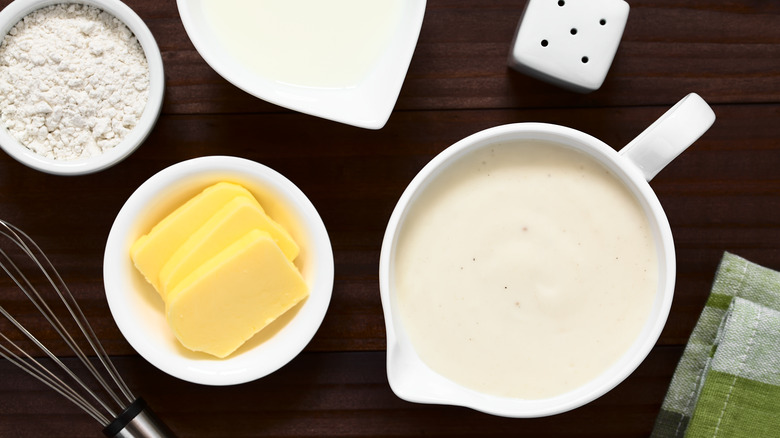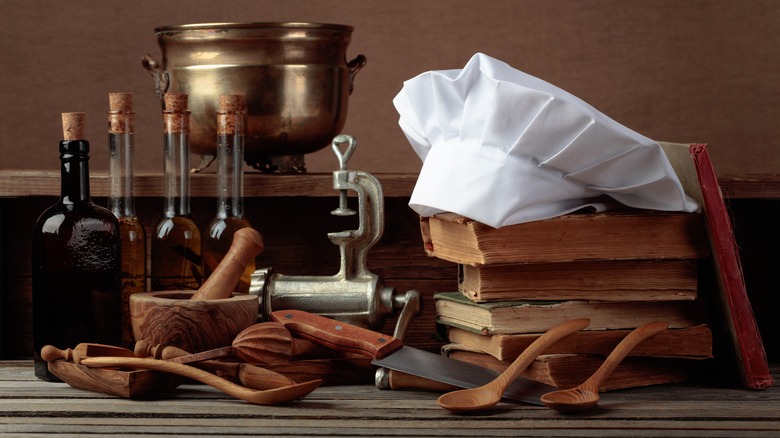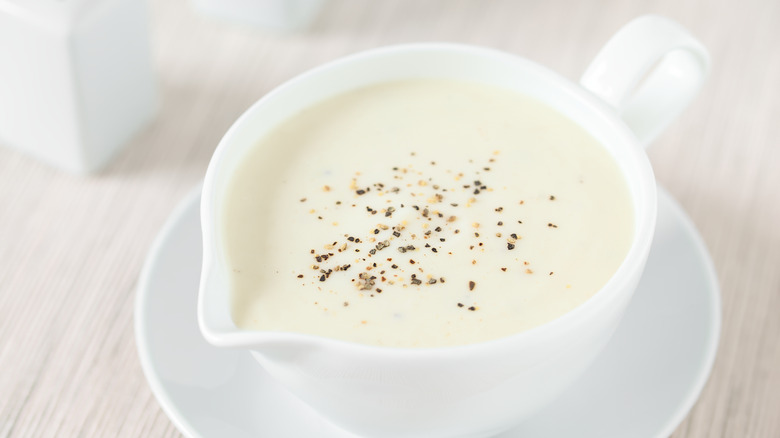The Royal Origins Of Béchamel Sauce
CORRECTION 10/5/23: A previous version of this article identified Auguste Escoffier as a French-American chef. Escoffier was French, he did not live in the United States.
The secret ingredient to custardy cheese soufflé, bubbly lasagne, and rich mac and cheese is actually no secret at all. It's béchamel, a French white sauce included in the five "mother sauces" of French cuisine, says MasterClass. Made from butter, flour, and milk (plus the optional sprinkle of ground black pepper and nutmeg), béchamel can be used on its own or as a base for other French sauces, like cheesy mornay. It might seem like no big deal to whip up, but like so many traditional French cooking methods, béchamel requires careful stovetop supervision and constant whisking, lest its flour burn and muddle the batch.
As its regal-sounding name suggests, the first pot of béchamel preceded many of the modern European-inspired dishes in which it now stars. We can't find any evidence that Marie-Antoinette drizzled the stuff over her roasted guinea fowl, but she might as well have. By the time she was born in 1755, per Britannica, a version of béchamel had already made a name for itself among the royals, says What's Cooking America.
Vincent La Chapelle and 'The Modern Cook'
According to The London Economic, the 1733 tome "The Modern Cook" houses the first known recipe for béchamel, courtesy of French master chef Vincent La Chapelle. Per its original introduction provided by the Internet Archive, the book contains instructions for preparing dishes for princes, ambassadors, noblemen, and magistrates. Having served in the royal kitchens of Willem IV, Prince of Orange-Nassau (to whom he dedicated his second cookbook, per Met Museum), La Chapelle certainly knew what he was doing.
In its earliest form, béchamel wasn't so much a sauce as it was a creamy, bouillon-enhanced fish soup. The original recipe, provided by the Internet Archive, instructs cooks to sauté minced parsley and leeks in "a good lump of butter," along with minced shallots, salt and pepper, nutmeg, and "a dust" of flour. Next comes a "Turbot boil'd in Court Bouillon," followed by cream, milk, or water that's stirred until thickened. Fast forward to the early 1800s, when another talented French chef changed the game for béchamel — and French cuisine altogether.
Marie-Antoine Carême said, 'Let them eat béchamel'
The concept of the French "mother sauces" that continue to shape French cuisine is owed not to Vincent La Chapelle, but to a once-poor Parisian food genius called Marie-Antoine Carême, whom Eater calls the first celebrity chef.
Not only is Carême (1784-1833) known for the intricate pièces montées he displayed outside his Patisserie de la Rue de la Paix in Paris, but he also took Vincent La Chapelle's béchamel to new heights by including it in what he deemed the four essential sauces of French cuisine, says NPR. While the French chef Auguste Escoffier (1846-1945) is responsible for modernizing the system and adding the fifth sauce, Carême is the undoubted progenitor. Béchamel shares the stage with velouté, sauce espagnole, sauce tomat, and hollandaise. Per Eater, Carême is "a key reason why French cooking has permeated nearly every country across the globe."


